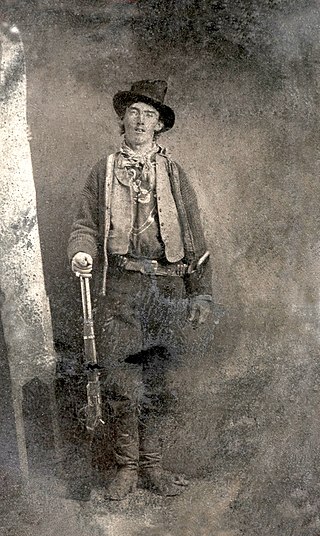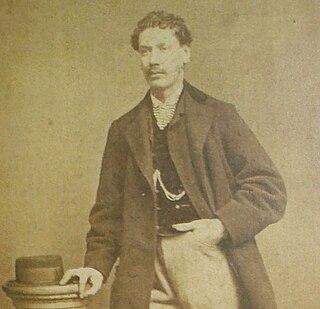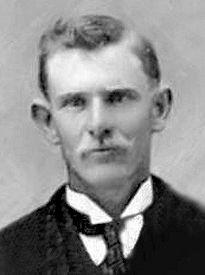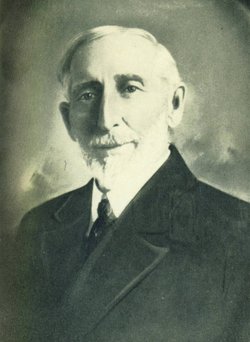
Reserve is a village in Catron County, New Mexico, United States. The town population was 293 at the 2020 census. It is the county seat of Catron County. Currently the village has two grocery stores, a hardware store, a bar, fairgrounds, and a health clinic. It is the site where Elfego Baca held off a gang of Texan cowboys who wanted to kill him for arresting cowboy Charles McCarty.

Henry McCarty, alias William H. Bonney, better known as Billy the Kid, was an American outlaw and gunfighter of the Old West who was linked to nine murders: four for which he was solely responsible, and five in which he may have played a role alongside others. He is also noted for his involvement in New Mexico's Lincoln County War.

The Lincoln County War was an Old West conflict between rival factions which began in 1878 in Lincoln County, New Mexico Territory, the predecessor of the state of New Mexico, and continued until 1881. The feud became famous because of the participation of William H. Bonney. Other notable participants included Sheriff William J. Brady, cattle rancher John Chisum, lawyer and businessmen Alexander McSween, James Dolan and Lawrence Murphy.

Gunfighters, also called gunslingers or in the late 19th and early 20th century gunmen, were individuals in the American Old West who gained a reputation of being dangerous with a gun and participated in shootouts. Today, the term "gunslinger" is more or less used to denote someone who is quick on the draw with a handgun, but this can also refer to those armed with rifles and shotguns. The gunfighter is also one of the most popular characters in the Western genre and has appeared in associated films, television shows, video games, and literature.

José Coby Frey Chávez y Chávez (1851–1924) was a Mexican-American outlaw from the New Mexican Territory, which is now the state of New Mexico, in the United States. He was said to be the son of a Spanish father and Apache mother. Chávez became an outlaw at a relatively young age when he joined the Lincoln County Regulators.

William Brocius, better known as Curly Bill Brocius, was an American gunslinger, rustler and an outlaw Cowboy in the Cochise County area of the Arizona Territory during the late 1870s and early 1880s. His name is likely an alias or nickname, and some evidence links him to another outlaw named William "Curly Bill" Bresnaham, who was convicted of an 1878 attempted robbery and murder in El Paso, Texas.

Elfego Baca was a gunfighter, law enforcement officer, lawyer, and politician in New Mexico, who became an American folk hero of the later years of the New Mexico Territory frontier. His goal in life was to be a peace officer, and for "the outlaws to hear [his] steps a block away". He is known for his involvement in an 1884 shootout in Frisco, New Mexico, as well as later fictionalized representations of his life in Westerns released during the mid-20th century.

A shootout, also called a firefight, gunfight, or gun battle, is an armed confrontation entailing firearms between armed parties using guns, always entailing one or more intense disagreements between the involved parties. The term can be used to describe any such fight, though it is typically used in a non-military context or to describe combat situations primarily using firearms.

The Earp Vendetta Ride was a deadly search by a federal posse led by Deputy U.S. Marshal Wyatt Earp for a loose confederation of outlaw "Cowboys" they believed had ambushed his brothers Virgil and Morgan Earp, maiming the former and killing the latter. The two Earp brothers had been attacked in retaliation for the deaths of three Cowboys in the Gunfight at the O.K. Corral on October 26, 1881. From March 20 to April 15, 1882, the federal posse searched southeast Cochise County, Arizona Territory for the men they believed were responsible for the attacks on Virgil and Morgan. Several suspects had been identified and were charged, but were soon released by the court, owing in some cases to legal technicalities and in others to the strength of alibis provided by the Cowboy gang. Wyatt subsequently pursued the suspects with a federal warrant.
The Gunfight at Hide Park, or the Newton Massacre, was the name given to an Old West gunfight that occurred on August 19, 1871, in Newton, Kansas, United States. While well publicized at the time, the shootout has received little historical attention despite resulting in a higher body count than the Gunfight at the O.K. Corral and the Four Dead in Five Seconds Gunfight of 1881. Unlike most other well-known gunfights of the Old West, it involved no notable or well-known gunfighters, nor did it propel any of its participants into any degree of fame. The story has transformed into legend due to reports that one of the participants, James Riley, walked away from the scene and was never seen again.
Andrew L. "Buckshot" Roberts was an American buffalo hunter, frontiersman and cowboy known for his last stand against the Lincoln County Regulators during the Gunfight of Blazer's Mills near Lincoln, New Mexico.

Josiah Gordon "Doc" Scurlock was an American Old West figure, cowboy, and gunfighter. A founding member of the Regulators during the Lincoln County War in New Mexico, Scurlock rode alongside such men as Billy the Kid.
The Lincoln County Regulators, or just the Regulators, were an American Old West deputized posse that fought in the Lincoln County War in New Mexico, during the late 19th century. They are well known for including Billy the Kid as a member.

San Francisco Plaza was the name of three towns in Catron County, New Mexico, United States. Located in the San Francisco River Valley, the towns were settled by Spanish settlers in the 1860s. Today Middle San Francisco Plaza is called Middle Frisco, Lower San Francisco is called Lower Frisco, and Upper San Francisco was renamed Reserve when U.S. Forest Service headquarters were built there.

Benjamin Franklin “Frank” Coe was an American Old West cowboy, gunman, and member of the Lincoln County Regulators.
The Gunfight at Blazer's Mill was a shootout between what were known as the Lincoln County Regulators and buffalo hunter Buckshot Roberts.

Ab Saunders was an American cowboy, and at times gunman, best known for his association with Billy the Kid, Charlie Bowdre, Frank McNab, Doc Scurlock, and Saunders's cousins Frank and George Coe, when he was a member of the Lincoln County Regulators, a deputized posse, during the 1878 Lincoln County War in the New Mexico Territory

Cochise County in southeastern Arizona was the scene of a number of violent conflicts in the 19th-century and early 20th-century American Old West, including between white settlers and Apache Indians, between opposing political and economic factions, and between outlaw gangs and local law enforcement. Cochise County was carved off in 1881 from the easternmost portion of Pima County during a formative period in the American Southwest. The era was characterized by rapidly growing boomtowns, the emergence of large-scale farming and ranching interests, lucrative mining operations, and the development of new technologies in railroading and telecommunications. Complicating the situation was staunch resistance to white settlement from local Native American groups, most notably during the Apache Wars, as well as Cochise County's location on the border with Mexico, which not only threatened international conflict but also presented opportunities for criminal smugglers and cattle rustlers.

Feuds in the United States deals with the phenomena of historic blood feuding in the United States. These feuds have been numerous and some became quite vicious. Often, a conflict which may have started out as a rivalry between two individuals or families became further escalated into a clan-wide feud or a range war, involving dozens—or even hundreds—of participants. Below are listed some of the most notable blood feuds in United States history, most of which occurred in the Old West.

The Gleeson gunfight, or the Gleeson shootout, was one of the last gunfights in the Old West, having occurred during the transition period between the "Old" and the "New." On March 5, 1917, the sheriff of Cochise County, Harry C. Wheeler, and his deputy, Lafe Gibson, were ambushed by a gang of Mexican alcohol smugglers near the town of Gleeson, Arizona. During the battle that followed, Wheeler and Gibson fought off the attackers and confiscated their alcohol, wounding at least one man in the process.















